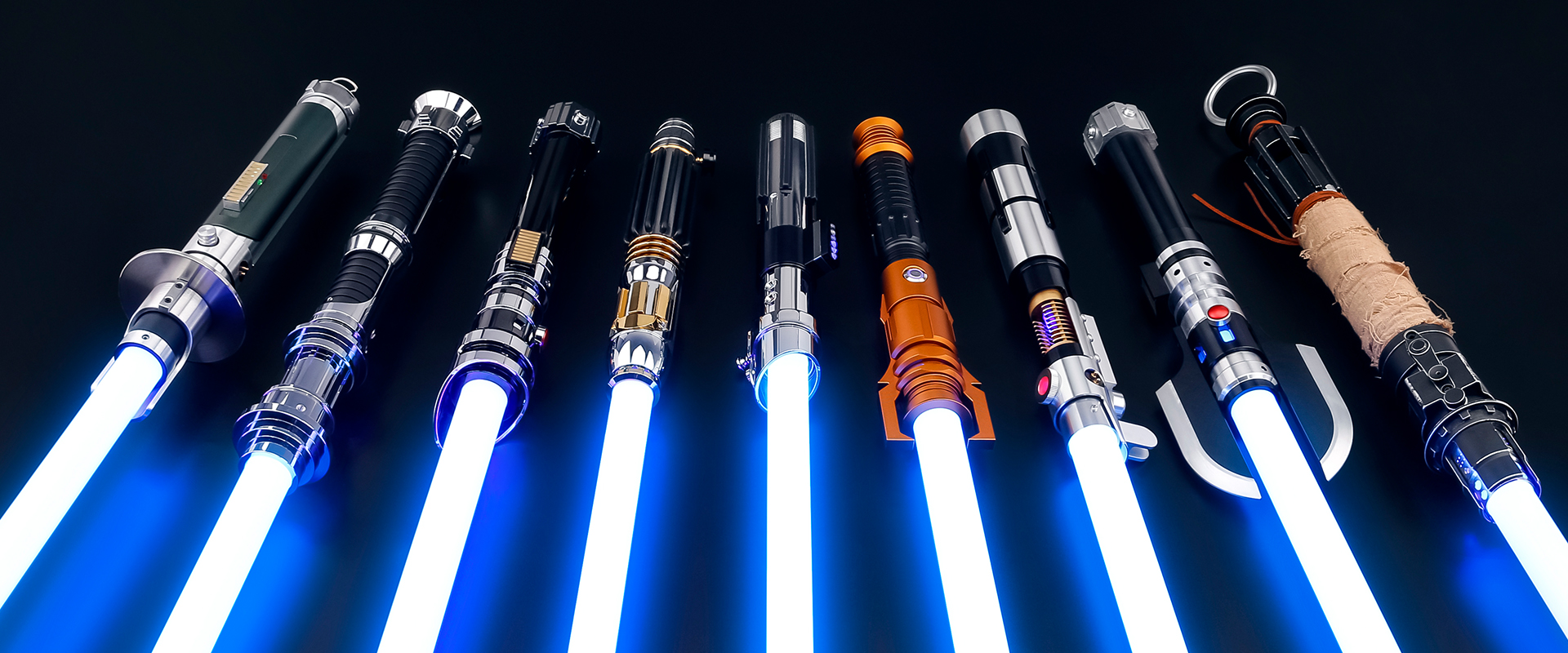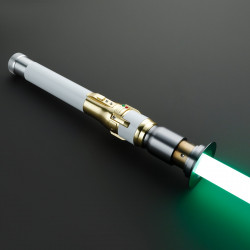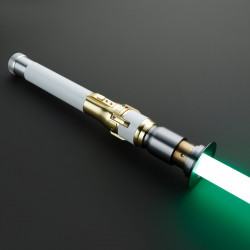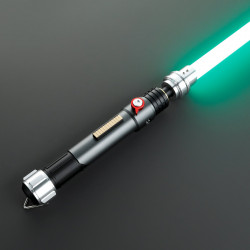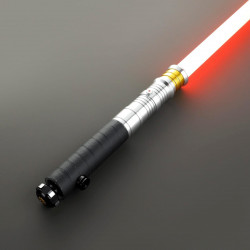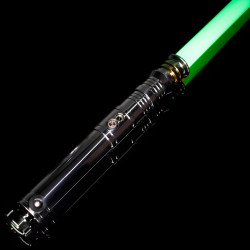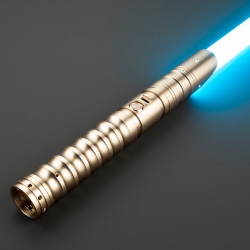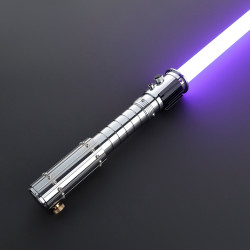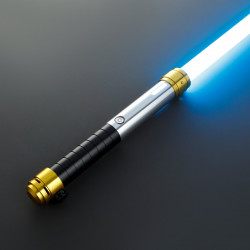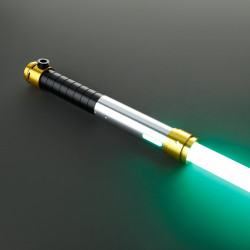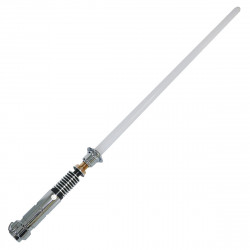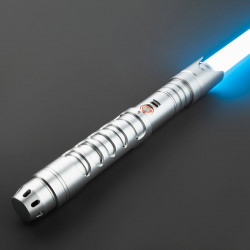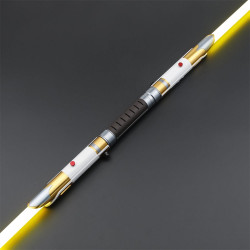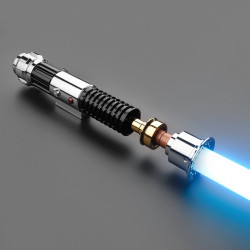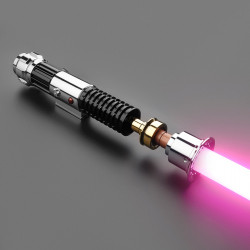
The Meaning of Lightsaber Colors
Throughout the Star Wars series, blue, red, and green are the most popular (and well-known) lightsaber hues. They help differentiate between the Force's good and dark sides. However, similar weapons in the Star Wars world are available in many different colors. For example, the orange Lightsaber was added to the canon with the publication of the video game "Star Wars Jedi: Fallen Order."
Varied people utilize lightsabers with varied color schemes based on their roles and the side of the Force they belong to; for those who are unaware, Jedi, Sith, and other force users attack and protect themselves using lightsabers.
We will describe the origins of a lightsaber's hue from its inception, as well as the significance of each shade. In addition to helping you better understand the characters based on their blades, this will help you decide which color appeals to you the most if you want to get your own Lightsaber. Pay close attention to the end if you're going to become an authority on the topic.
How is the Color of a Lightsaber determined?
These weapons are primarily made up of a handle that serves as an emitter, an intense retractable plasma beam, and a Kyber crystal that serves as the light beam's primary power source. These Kyber crystals are responsible for the many colors of the lightsabers. With the exception of the Sith, who use a synthetic kyber crystal, they are uncommon, associated with the Force, and derived from nature. They are covertly well-protected and can be found on a number of worlds throughout the cosmos.
Kyber crystals aren't naturally colored; instead, their hue is determined by the Jedi, who found them based on their decisions or personalities. As a result, they may offer lightsabers in a variety of colors; however, additional techniques are used to get colors like the Sith's signature red.
Are you a massive fan of Star Wars? Then, cling on to your ship for this space voyage where we will jointly learn the significance and desired symbol of every lightsaber color.
The Blue Lightsaber
There's a reason why the blue Lightsaber is essential. Star Wars Episode IV, "A New Hope," features the first on-screen activation of the iconic Skywalker lightsaber. Blue is the most popular color they use, but it's not the only one.
Blue blade is linked to the Jedi Guardians because its practitioners place more emphasis on their Lightsaber fighting prowess than on employing the Force. An excellent illustration of this is Anakin Skywalker, who was far more skilled at lightsaber combat than with emotional and Force control.
Mostly in relation to what the Jedi stand for, blue lightsabers are supposed to symbolize protection, bravery, righteousness, and courage. However, it should be mentioned that if the Jedi is not spiritually connected to its crystal, the Lightsaber's blue hue alone means very nothing. Characters like Tera Sinube, Anakin Skywalker, Luke Skywalker, and Obi-Wan with his three lightsabers are examples of this color in the series.
The Green Lightsaber
Jedi utilize green lightsabers more often than any other hue. Those who respect intelligence, harmony, helpfulness, cooperation, spirituality, and goodwill are linked to the color green. The oldest and wisest Jedi frequently wield the green Lightsaber. The Lightsaber used by Yoda, the most knowledgeable Jedi master, is the most illustrative example. Other exceptional fighters include Luke Skywalker, who wields a green lightsaber, and Qui-Gon Jinn.
The hallmark of a Jedi Consular—a Jedi who considers and deliberates before acting—is a green lightsaber. Due to their heightened sensitivity to the Force, Green blade Jedi put the Force, meditation, and conversation above lightsaber fighting.
The Purple Lightsaber
Purple is another extremely uncommon hue utilized by Jedi, particularly by Mace Windu. Samuel L. Jackson, whose favorite color is purple, actually requested the purple Lightsaber. In the context of the Star Wars cinematic universe, this uncommon Lightsaber is, therefore, meaningless. A purple lightsaber, on the other hand, symbolizes the user's harmonious relationship with the Force's dark and light aspects in the expanded world.
A Force user with a purple weapon was typically aggressive, daring, and reckless, leading his allies into battle fearlessly because purple is a blend of red and blue. It denotes doubt, moral ambiguity, and rebuilding. It demonstrates a connection to both the Force's dark and light aspects. These Jedi are perfectly balanced individuals who understand how to maximize both aspects.
Mace the Jedi When Windu and Darth Sidious faced off in Star Wars: Episode III: Revenge of the Sith, Windu's purple Lightsaber, which had first been seen in Episode II: Attack of the Clones, was lost after it fell out of a window.
The Yellow Lightsaber
The Jedi Sentinel is most frequently thought of when a Jedi brandishes a yellow lightsaber. One of the three "schools" of the Jedi Order, the Sentinels serve as a kind of intermediary between the Consular and the Guardians, as you may already be aware. The Sentinels attempted to blend the best aspects of both planets, while the Consular stressed the need for diplomacy, and the Guardians honed their unmatched fighting abilities. They can take on a variety of duties, but their most well-known duty is likely that of the Jedi Temple Guard, an anonymous security force.
The Jedi Temple guards utilize this color on their lightsabers, which have two yellow blade spikes. Although not much is known about this specific lightsaber color, these striking-looking pikes were associated with the role rather than the person. In other words, they were not regarded as the guards' personal property; instead, they were utilized to carry out the responsibilities of that particular post. At one point, characters like Ahsoka herself and Asajj Ventress used a yellow lightsaber.
In Skywalker's Ascension, audiences finally witnessed someone wield a yellow lightsaber, something they had never seen on the big screen in the Star Wars series. In fact, Rey briefly wields a yellow lightsaber in the movie's closing sequence; the hilt of the weapon seems to have been made from the staff she used to carry before the advent of Jedi.
She created this yellow Lightsaber for herself, which appears to represent the harmony she has discovered between the Force's dark and light sides. It's similar to the purple Lightsaber, perhaps. She is simply Rey; she is neither the next Anakin nor the next Luke. This, based on conjecture, might match the description of a Jedi Sentinel. You can discover the answers on your own.
The Orange Lightsaber
In the canon of Star Wars, an orange lightsaber is a very uncommon blade color that only appears in the 2019 video game Star Wars Jedi: Fallen Order. There isn't a story yet because the color has been revealed as a way to encourage pre-ordering the game. The Lightsaber that Cal Kestis uses can be altered to include several colors. The Old Republic era is where orange lightsabers are most prevalent in the Expanded Universe. In the 2012 comic book series Star Wars: Knights of the Old Republic: War, Mandalorian knights wield orange sabers.
During the Mandalorian Wars, a band of renegade Jedi known as the Mandalorian Knights, founded and led by former Jedi Council member Dorjander Kace, undermined the Republic's military endeavors. Since then, theories have surfaced, but none of them have ever been verified.
For instance, it has been hypothesized that orange lightsabers were only used by Jedi who had sworn to abstain from using them unless absolutely required, which may be why they were never featured in the films. Another notion is that they are caused by a crimson track left behind when a red kyber crystal partially heals.
The White Lightsaber
Ahsoka Tano's use of the white lightsabers demonstrates her Force proficiency. While in hiding following the fall of the Jedi Order, Ahsoka recovered the Kyber lightsaber crystal from an Inquisitor she had murdered during the Imperial occupation of Raada. When this one first emitted a red saber blade, Ahsoka used the Force to purify it and turn it white. The white lightsabers that Ahsoka Tano used came to symbolize her neutral and independent nature. As one might anticipate, Ashoka Tano's blades would have been either blue or green, or possibly purple or yellow, if he had indeed been a Jedi Knight.
However, they became white for Tano, highlighting her status as a Force user: dedicated to the side of light but uninterested in the Jedi's ideals and code of ethics. She used these new white crystals in a shoto blade and two lightsabers. The White Lightsaber might be interpreted as a symbol of impartiality, self-reliance, and disassociation from the Jedi Order.
The Red Lightsaber
The Sith Lords' trademark is the red Lightsaber. The Sith are unable to form a spiritual bond with their Kyber Crystals, in contrast to the Jedi, who share a bond with them, causing their colors to change. Additionally, the Sith had no access to the valuable gems because the Jedi controlled the planet Ilum, which is where the Kyber gems were discovered. They were forced to make do. As a result, the Sith started creating their artificial lightsaber crystals using special ovens and intense meditation sessions.
The "bleeding" procedure involves pouring all of the destructive emotions—such as fear, hatred, and others—into the crystal, which causes it to "bleed" and turn crimson. Regarding their owner's personality, warriors who wield them have a propensity to become easily agitated. The crimson lightsaber represents a person who is unable to control his emotions and who uses cruelty, violence, and ruthlessness to resolve nearly all of his issues.
These fighters are incredibly persistent individuals who will do whatever it takes to accomplish their objectives, even if it means giving up all they value—or what's left of it. The Sith that we all know, such as Darth Vader, Count Dooku, Darth Maul with his two-bladed Lightsaber, or Darth Sidious and Kylo Ren with his Quilon saber, were the ones who employed this hue the most.
The Black Lightsaber
The Dark-saber, which Mandalorian Tarre Vizsla made, is not your typical weapon. He created a narrow, flat, dark obsidian blade that was shorter than most. The uncommon weapon resembles a sword more than a lightsaber. Furthermore, compared to a traditional lightsaber, the Dark-saber produces a higher-pitched sound effect. There is also the sound of an electric crackling when it strikes another blade.
There is just one of these sabers, making it highly uncommon. Following Vizsla's passing, the black Lightsaber was stored at the Jedi temple until it was taken by House Vizsla members and handed down through the generations. For the Mandalorian's, the weapon has come to represent leadership, and in accordance with Mandalorian custom, the only way to rightfully acquire it is to vanquish its previous owner in combat.
The Dark-saber's symbolic significance tends to motivate people to uphold this ancient tradition. For its owner, the black Lightsaber represents leadership. This Lightsaber, commonly known as the Dark-saber, was initially shown in the final episode of the first season of the television show The Mandalorian.
Other Lightsaber Colors in Star Wars
The Expanded Universe contains numerous hues that are not yet included, although all of the colors listed above are part of the Star Wars canon. More additional colors are created in the Extended Universe by using crystals other than Kyber to build lightsabers. The Expanded Universe contains a vast array of lightsaber hues, including bronze, cyan, gold, silver, bluish-green, and many more. In the near future, some of these hues could be added to the canon of Star Wars.
You will need a lightsaber if you wish to become a Jedi. There are twelve distinct hues available for our lightsabers. This implies that you won't have to choose if you prefer multiple colors because you can hold them all in your hands:
